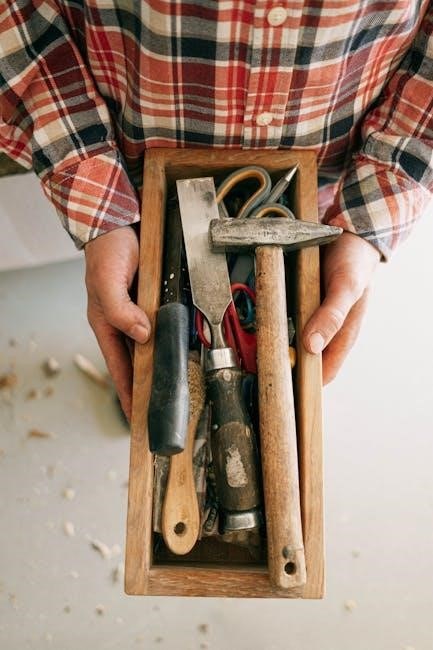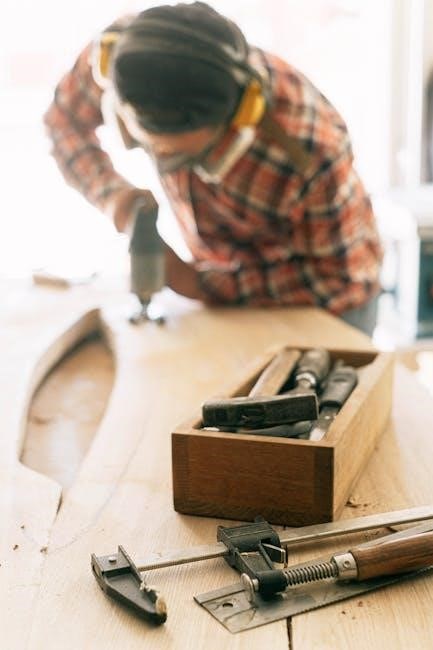
This manual provides essential guidance for setting up, operating, and maintaining your Craftsman radial saw. It covers safety, features, and troubleshooting to ensure safe and effective use.
Overview of the Manual
This manual serves as a comprehensive guide for the Craftsman radial saw, detailing its setup, operation, and maintenance. It includes safety guidelines, assembly instructions, and troubleshooting tips to ensure optimal performance. The document covers various models, providing specific instructions for each, and emphasizes proper usage to prevent accidents. Readers will find detailed diagrams and step-by-step procedures for aligning and calibrating the saw, as well as advice on routine maintenance. By following this manual, users can maximize the tool’s efficiency and longevity while adhering to safety standards. It is designed to be user-friendly, catering to both novice and experienced operators.
Importance of Reading the Manual
Reading the manual is crucial for understanding the Craftsman radial saw’s features, safety protocols, and operational procedures. It ensures users are aware of potential hazards and know how to mitigate risks. The manual provides detailed instructions for assembly, alignment, and maintenance, which are essential for optimal performance. By familiarizing yourself with the content, you can avoid costly mistakes and prolong the tool’s lifespan. Additionally, the manual outlines emergency procedures and troubleshooting steps, making it an indispensable resource for safe and effective operation. Proper understanding of the manual ensures compliance with safety standards and enhances overall user experience.
Key Components of the Radial Saw
The Craftsman radial saw features a powerful motor, a durable blade, and a robust arm assembly. The blade is supported by precision bearings for smooth operation. The arm and carriage system allows for precise adjustments and alignment. Additional components include the fence for straight cuts, the miter gauge for angled cuts, and the safety guard to protect the user. Understanding these parts is essential for proper setup and operation. Each component plays a critical role in ensuring accurate and safe cutting. Familiarizing yourself with these elements will enhance your ability to use the saw effectively and maintain its performance over time.

Safety Guidelines and Precautions
Always wear protective gear, ensure the work area is clean, and avoid loose clothing. Follow all instructions in the manual to minimize risks and ensure safe operation.
General Safety Rules
Always wear safety glasses, a dust mask, and hearing protection when operating the saw. Ensure the work area is clear of clutter and well-lit. Tie back loose clothing and long hair, and avoid wearing jewelry that could catch in the machine. Keep children and bystanders away from the work area. Never operate the saw while tired or under the influence of drugs or alcohol. Ensure the power cord is dry and free from damage. Always use the correct blade for the task and keep it sharp to prevent kickback. Follow all instructions in the manual and take regular breaks to maintain focus.
Specific Hazards and Warnings
Beware of sharp edges and moving parts that can cause severe cuts. Kickback is a major hazard; ensure proper blade alignment and avoid overloading the saw. Never reach near the blade while it is moving. The saw produces excessive noise and dust, so appropriate protective gear is essential. Overheating can occur with prolonged use; monitor the motor and allow it to cool. Keep flammable materials away due to potential sparks. Always maintain a firm grip on materials to prevent slipping. Misuse of the saw can lead to serious injury, so adhere strictly to the manual’s guidelines and safety precautions.
Emergency Procedures
In case of an emergency, immediately turn off the power and disconnect the saw from the power source. If a person is injured, provide first aid and seek medical attention if necessary. For fires, use a fire extinguisher rated for electrical fires. If chemicals are spilled, ventilate the area and follow cleanup procedures. Never attempt to move someone with serious injuries unless there is immediate danger. Call emergency services if the situation is severe. After the incident, report it and conduct a safety review to prevent future occurrences. Always prioritize safety and follow proper protocols to minimize risks;

Installation and Assembly
Unpack the saw carefully and inspect for damage. Follow the step-by-step assembly guide in the manual. Ensure proper alignment and calibration for accurate operation. Refer to the PDF manual for detailed instructions.
Unpacking and Initial Inspection
When you receive your Craftsman radial saw, carefully unpack and inspect for damage. Check all components, including the saw, table, and accessories. Verify the model number (e.g., 113.197110 or 113.197150) matches your manual. Ensure no parts are missing by comparing against the parts list. Inspect the saw’s alignment and lubrication, as it may arrive pre-lubricated. If damaged, contact customer support immediately. Refer to the PDF manual for detailed unpacking instructions and initial setup guidelines to ensure proper assembly and functionality.
Step-by-Step Assembly Instructions
Begin by attaching the radial saw to a sturdy table or stand using the provided hardware. Align the saw arm according to the manual’s specifications. Secure the motor and ensure all bolts are tightened properly. Attach the blade guard and anti-kickback device. Connect the power cord and test the saw’s movement to ensure smooth operation. Refer to the parts list (e.g., for models 113.197110 or 113.197150) to verify all components are included. Follow the alignment and calibration steps carefully for accurate cuts. Always disconnect power before making adjustments. Ensure the saw is properly assembled before use to avoid malfunctions.
Alignment and Calibration
Align the saw arm to ensure proper movement and accurate cuts. Adjust the blade angle using the provided tools, ensuring it aligns with the fence. Use a combination square to verify the table and fence are square to the blade. Tighten all alignment bolts securely. Calibrate the saw’s depth and angle settings according to the manual. Test the saw with a small piece of wood to confirm accurate cuts. Refer to the parts list (e.g., for models 113.197110 or 113.197150) if adjustments require specific components. Proper alignment and calibration are critical for safe and precise operation. Consult the manual for detailed calibration steps.

Operating the Radial Saw
Operate your Craftsman radial saw safely by following proper techniques and guidelines. Adjust settings carefully, use protective gear, and refer to the manual for model-specific instructions.
Powering On and Off
Always ensure the radial saw is properly powered on and off to maintain safety and functionality. Locate the power switch, typically found on the main housing. Before turning it on, ensure the power cord is securely connected to a suitable outlet. Check that all guards are in place and the work area is clear of debris. For models with variable speed settings, adjust the speed control before powering on. To turn off, press the power switch firmly and allow the blade to stop completely before leaving the saw unattended. Refer to your specific model’s manual for any additional power-related instructions.
Adjusting Settings and Features
Adjusting the settings and features of your Craftsman radial saw ensures precise cuts and optimal performance. Begin by setting the miter angle, ensuring it is securely tightened after adjustment. Use the variable speed control to match blade speed with the material being cut. For models with adjustable fences, align them parallel to the blade for accurate results. Regularly check and replace worn or dull blades to maintain cutting efficiency. Some models may also feature adjustable guards or depth stops, which should be set according to the specific cutting task. Always refer to your manual for model-specific adjustment procedures to ensure proper functionality and safety.
Basic Cutting Techniques
Mastering basic cutting techniques ensures accurate and safe operation of your Craftsman radial saw. Begin by aligning the material firmly against the fence, ensuring it is flat and secure. Use the provided miter gauge for angled cuts, and always maintain a steady feed rate. Keep hands away from the blade path and utilize push sticks or other safety accessories when necessary. For rip cuts, align the material with the fence, while crosscuts benefit from the miter gauge. Always maintain sharp blades to prevent tear-out and ensure smooth cuts. Refer to your manual for specific techniques tailored to your saw model.

Maintenance and Troubleshooting
Regularly inspect and lubricate moving parts, check blade sharpness, and ensure proper alignment. Address issues like uneven cuts or motor noise promptly for optimal performance and longevity.
Routine Maintenance
Regular maintenance is crucial for optimal performance and longevity of your Craftsman radial saw. Lubricate moving parts periodically to reduce friction and wear. Inspect the blade for sharpness and damage, replacing it when necessary. Check and tighten any loose bolts or screws, ensuring proper alignment and calibration. Clean the saw and work area to prevent dust buildup, which can affect accuracy. Always disconnect the power cord before performing maintenance tasks. Refer to the manual for specific lubrication points and recommended schedules. Proper upkeep ensures safe operation, precise cuts, and extends the life of your radial saw.
Common Issues and Solutions
Like any power tool, the Craftsman radial saw may encounter issues. Common problems include blade misalignment, motor overheating, or uneven cuts. For misalignment, recalibrate the saw according to the manual. If the motor overheats, ensure proper ventilation and avoid continuous operation. Uneven cuts may result from a dull blade; sharpen or replace it as needed. Dust buildup can impair performance, so regularly clean the saw and work area. Always refer to the troubleshooting section for specific solutions. Addressing these issues promptly ensures optimal performance and extends the tool’s lifespan. Consult the manual for detailed repair guidance if problems persist.